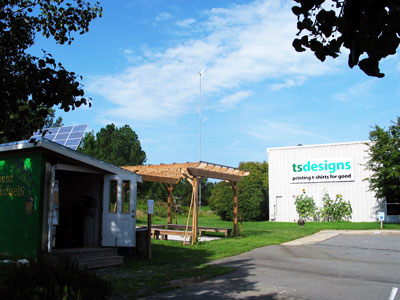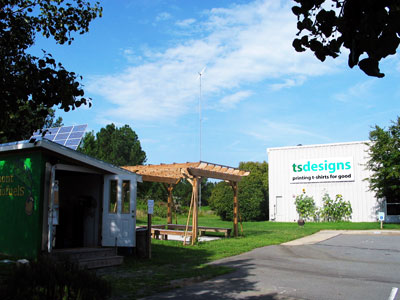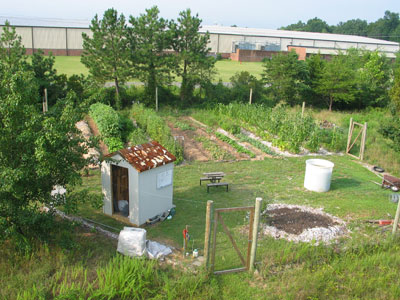
How TS Designs supports their community with a local supply chain.
By TS Designs
TS Designs (TSD) is a screenprinter located in Burlington, NC. We were founded in 1977 as a small screenprinting shop. By the late 80s and early 90s, TSD had over 100 employees and was printing apparel for companies like Tommy, Nike, Polo, Gap, etc. However, after the passage of NAFTA, that business began moving to Mexico (and later, overseas). Owners Tom Sineath and Eric Henry decided to change TS Designs’ business model to Triple Bottom Line – a model that considers economic prosperity, social justice, and environmental stewardship as three equal considerations. Since then, our product offerings – and customers – have changed dramatically in a more sustainable direction.
Building Community Development into the Program

Cotton of the Carolinas began as the answer to a growing problem. Our flagship product was a certified organic cotton t-shirt made in America, but we found that more and more of that cotton was being shipped in from overseas. North Carolina is the United States’ third largest grower of conventional cotton, and over half of that cotton is shipped offshore to be turned into products. So while a valuable commodity grown in our home state was sent outside the country, we were importing a similar product.
We decided that didn’t make much sense. So we set out to build an apparel supply chain that built a product, from dirt-to-shirt, right here in North Carolina. We didn’t create a new company to handle the Cotton of the Carolinas project. Rather, we researched supplier options and started making calls. Since we already had a close working relationship with our knit, finish and cut/sew providers, all we had to do was find the farmer/ginner and spinner. Of course, handling our own production from start to finish had a pretty big learning curve, but we’re constantly adjusting how we manage the whole supply chain.
Since existing infrastructure already existed to do pretty much everything we wanted, the only adjustment any of the vendors had to make was to ensure that lot numbers were present to track the cotton as it moved through the process. That was only really a concern at the spinner, as most of the time spinners combine cotton from several locales to create a more consistent product from year to year. Our current spinner, Hill Spinning, has done a great job cleaning equipment between lay downs of our fiber so we know that only our farmer’s cotton is present in our yarn.
Our labor standard at the moment is just that the vendors be based in North Carolina and employ residents. As we continue to grow the program, we’d like to get more involved in how our suppliers do business, but for the moment (and given what small cookies we are to some of our vendors), we’re happy to know that the workers are treated according to U.S. labor standards (which are tremendously better than overseas).
Successes and Challenges
Cotton of the Carolinas is now in its fourth year. The product focuses on three main objectives:
- Support jobs here in our home state. Currently the suppliers of Cotton of the Carolinas employ over 700 North Carolineans.
- Create a completely transparent supply chain. Each shirt contains a tracking code in the label that corresponds to a map on cottonofthecarolinas.com. That map shows pictures, addresses, and contact information for every supply that is involved in making the wearer’s shirt.
- Reduce the transportation footprint of each shirt – because our supply chain is so local, each shirt travels fewer than 750 miles from field to printed product. A typical t-shirt can travel over 17,000 miles to accomplish the same.

We’ve seen demand increase every year of the program, and look forward to offering more style options.
As for challenges, we’ve certainly had our share. We commit to a certain amount of cotton in the fall of every year, and that cotton has to go through the entire supply chain until shirts exist to be printed. As a result, forecasting is essential, and keeping track of the cotton at each stage of the process can be difficult, especially since we spin yarn in small amounts at a time to avoid holding too much inventory.
Timelines for creating a custom shirt can be a challenge as well. Most screenprinters buy products from a distributor that holds shirts on a shelf. Conversely, moving from yarn to fabric can take 2 months, and from fabric to cut/sewn shirt another month after that. Making sure we’re on top of immediate needs is important, and we occasionally find ourselves in tight inventory situations.
Fortunately, we’re improving our systems for handling and tracking production. Every harvest season brings a new learning experience, and if there’s one thing we’re good at, it’s adapting and evolving to better manage complexity in how we operate.
Three examples include :
- Scaling down our business after the large volume clients left after NAFTA really forced us into being more adaptable and light on our feet. One of our biggest assets in terms of our adaptability is our production floor staff. Pretty much everyone out there can fulfill 3 or more roles. Perhaps the best example is Doug Murphy – he can load, unload, and inspect on a press, single-handedly manages our ink lab (both mixing and development), helps develop new dye colors (which is different from ink development), can work at the dye house as a backup, inspect after dye, and has a chemistry background so he helps me with technology development projects related to our REHANCE printing technology. Back in the heyday of TSD, each of those jobs would be done by an individual person. And that’s just one guy. We have an enormous amount of human capital in production, and that resource translates well into handling complexity in orders.
- We’ve also developed our own internal production system to handle our orders. Since it’s tailored to our business, we can manage complex details of our custom orders with far greater efficiency and, more important, accuracy, than we could a few years ago.When you combine our superior logistical systems and excellent people, we’re able to rapidly manage development projects to move us forward.
- Another example is the re-formulation of our REHANCE chemistry. A few years ago, the chemical company responsible for the development and supply of our REHANCE ink was purchased by a much larger competitor. After a year or two, they started making it clear they weren’t interested in supplying such a specialized product to one (comparatively) small customer, so we had to scramble for alternatives. We were able to not only completely re-formulate REHANCE so that we could source all the component materials and mix the ink ourselves, we also lowered the cost, improved the environmental footprint, and improved its effectiveness. Entirely in-house.
Again, developments like this are possible for us because we have people with the capacity to learn about new processes and to apply them to our business, and because of our ability to manage these involved projects without them getting lost on the back-burner. Right now we’re at varying stages of four different research projects related to REHANCE and garment-dyeing with the goal of further improving our dye color consistency, lowering our costs, and offering new, even more environmentally-friendly options.
Principal Learnings and Tips
When a typical screenprinter purchases a t-shirt, it’s from a distributor that stocks the product on the shelf. That printer doesn’t have to get involved in purchasing ginned cotton, contracting to have it spun, knit, finished, cut, and sewn, nor with the costing of loss-in-process, financing, turn times, and inventory. Unfortunately, the product we really wanted – one that was grown and made in North Carolina with a transparent supply chain – didn’t exist, so we decided to re-invent the wheel.
The greatest lesson we learned is that if you’re developing a new product or service that requires that you learn processes outside your normal core competencies, make sure you have a quick-learning, well-organized project manager who will manage the details of getting up and running. Without a central conduit through which all project information flows, it’s easy to run into delays, mistakes or worse.
The current project manager (Eric Michel) started as an intern in 2005 and began fixing problems where he saw them. Eventually Eric Henry found he could drop ideas with this individual and he would make them happen. Eventually he started coming up with the ideas himself (like developing our production system).
The biggest takeaway from the experience is that Eric Michel didn’t know anything about screenrpinting or textiles when he started. He didn’t even know what TS Designs did – he was just looking for a summer job. More importantly, he was the type of person who wants to learn everything he can about what he’s working on, and that translated into a good match for what he is doing – managing an array of projects.
So if you’re looking for a person to move you forward with new projects, you don’t necessarily need someone with experience in what you do. In fact, sometimes it’s best to find someone who specifically doesn’t know anything about what you do. If you can find someone who’s sharp, they can bring new eyes to old problems (or identify problems you’ve never even recognized) and might develop solutions you never would’ve thought of. The capacity and inclination to learn is more important than established knowledge.


